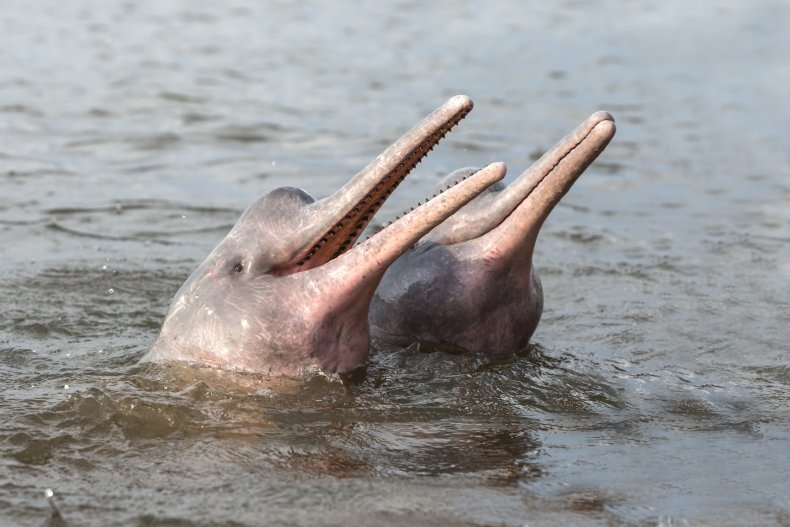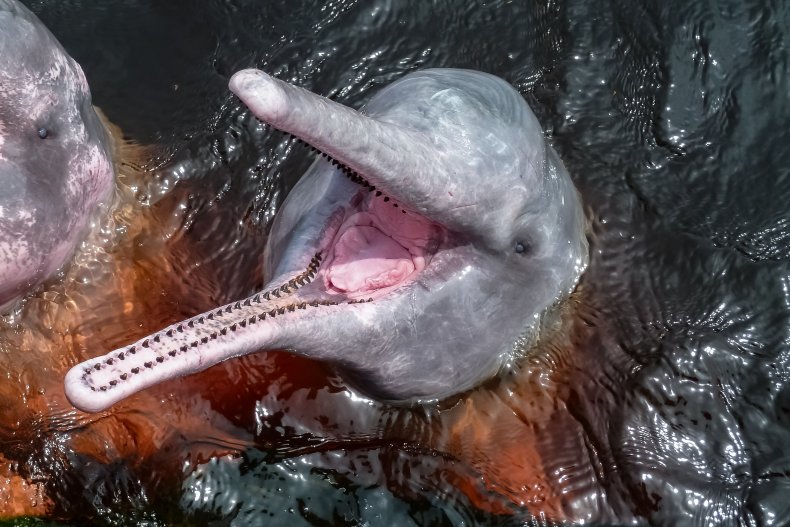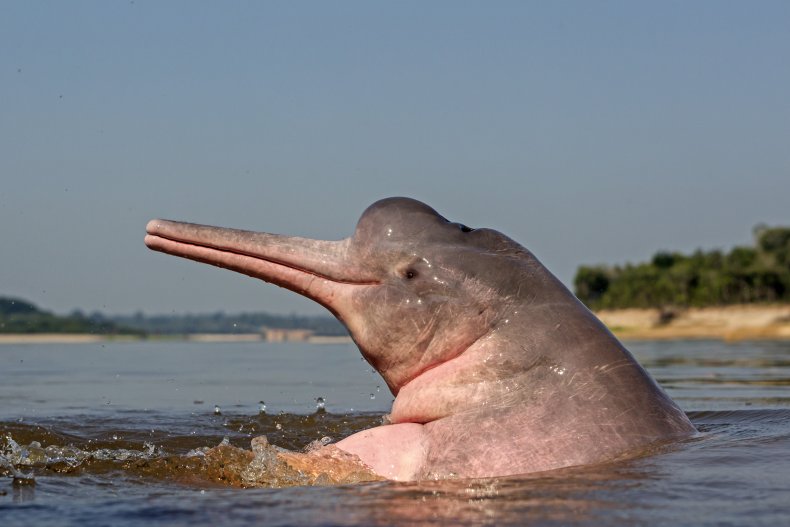A woman was swimming in a river in Santa Rosa de Yacuma, Bolivia, when a river dolphin bit her foot, peeling off a chunk of flesh and exposing the bone.
Claire Bye, a 28-year-old from the U.K., had been swimming with a tour group, with other tourists and children also playing with the pink river dolphins in the river. She had left the water when the dolphins began to act more restlessly after a child tried to pick one of the dolphins up, and was bitten when she briefly re-entered the water to retrieve a water bottle, the Independent newspaper reported.
According to experts, pink river dolphins very rarely attack humans unless they are feeling threatened.

Stock image of two Amazon river dolphins with their mouths open. A woman from the U.K. was bitten by a river dolphin, resulting in a deep wound on her right foot.ISTOCK / GETTY IMAGES PLUS
“River dolphins are non-aggressive creatures. It is just the opposite, they are very curious and charismatic animals,” Mariana Paschoalini Frias, a river dolphin researcher at Instituto Aqualie and dolphin strategist at WWF-Brasil, told Newsweek.
She described what happened in Santa Rosa de Yacuma as a specific and one-off episode, citing “disordered nature tourism”. “Swim with river dolphins” tourism had originated in Brazil with practices based on providing food and the bad example had spread throughout the Amazon region, leading to cases such as the Bolivian incident, she said.
“River dolphins have no reason to attack a human being unless it feels threatened. I believe that is the case at Santa Rosa de Yacuma,” she said.
Pink river dolphins, also known as Amazon river dolphins, are found around the Amazon river basin. They are the largest species of river dolphin, with adult males growing up to 8.2 feet long, and have 25 to 28 pairs of thin teeth on each side of their long jaws. So-called for their pink hues, these strange creatures are classified as “endangered” on the IUCN Red List, as of 2018.
“Harassing any marine or freshwater cetacean is against laws protecting endangered species, including in Bolivia where this dolphin is considered a symbol species and national natural heritage,” Frias said.

Stock image of a river dolphin with its mouth open, showing its sharp teeth.ISTOCK / GETTY IMAGES PLUS
Bye described to the Independent how after one child tried to pick up a dolphin, the animals began to act aggressively, with several people leaving the water with scrapes on their legs, having been bitten mildly by the dolphins.
Bye left the water after the dolphins started acting aggressively, standing on the pontoon and instead playing with them using a water bottle. After dropping the bottle in the water, she stepped into the river to retrieve it, and that’s when the dolphin bit her.
The dolphin bit into her foot for around 20 seconds, and caused a huge gash, with Bye saying that she could see her bone.
“River dolphins have a long rostrum and strong jaws,” Frias said. “To defend themselves they can use their strength, agility and mobility. Let it be clear, only when cornered and under threat. Inside water our body is [less] weight than outside, resulting in more fragility compared to a naturally aquatic species. In other words, river dolphins are in their natural habitat and are wild, it is hard to predict levels of damage, but humans can be hurt when hit by a dolphin leap that can reach 200kg [440 pounds] weight and 2m [6.5 feet] length.”
Bye was taken to hospital, first locally, then to Rurrenabaque, Bolivia. After the wound became infected, she was taken to Cemes Hospital in La Paz. Once home in the U.K., Bye underwent skin flap surgery, with tissue from her groin being transplanted to her foot.

Stock image of a pink river dolphin with its pink underside on show.ISTOCK / GETTY IMAGES PLUS
The river dolphins in this area are facing several threats, ranging from river pollution and river damming to human tourism.
“In addition to disorderly tourism, river dolphins face several threats like accidental catches in gillnets (bycatch) … population fragmentation, habitat loss and genetic diversity by hydroelectric dams, contamination by mercury and other pollutants, direct conflicts with fishermen,” Frias said. “All river dolphin populations in the world are declining in numbers, and it is not different in the Amazon (Bolivia, Brazil, Colombia, Ecuador, Peru, Venezuela and Guyana).”
They are often fished to be used as bait for other species, usually when fishing for piracatinga, also known as the vulture catfish.
“Threats are directed captures to be used as an attractant in the capture of Calophysus macropterus [vulture catfish], dams, climate change and mercury contamination,” Federico Mosquera Guerra, a postdoctoral researcher at Pontificia Universidad Javeriana in Colombia, told Newsweek.
According to the WWF, the mercury pollution comes from small-scale gold mining activities nearby, which accumulates up the food chain in the river system.
The IUCN estimates that the population of these dolphins is halving every 10 years.







